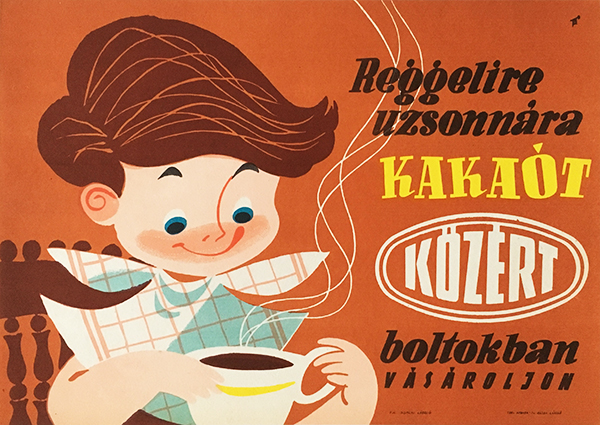
Description:
Tram poster to promote the State Owned Supermarket (Közért). Közért was the grocery store during Socialist times where all kinds of foodstuff could be purchased. The State Owned Supermarket was the equivalent of a regular supermarket but was a nationalized version of that. The state's purpose with posters was - besides of course many others - to make the everyday people feel that everything they might need is supplied by the government and is easily accessible in the shops. However, this wasn't exactly the case. There was rather a lack of supply in the Socialist times even though posters of the era tell the opposite.
The poster advertises cocoa. It suggests to drink this hot drink for breakfast and in the afternoon and buy it at Közért. The composition shows a charming boy who is licking his lips before tasting the delicious hot cocoa. The whole composition evokes the atmosphere of a home.
Hot chocolate, also known as drinking chocolate, cocoa, and as chocolate tea in Nigeria, is a heated drink consisting of shaved chocolate, melted chocolate or cocoa powder, heated milk or water, and usually a sweetener. Hot chocolate may be topped with whipped cream or marshmallows. Hot chocolate made with melted chocolate is sometimes called drinking chocolate, characterized by less sweetness and a thicker consistency. The first chocolate drink is believed to have been created by the Maya around 2,500–3,000 years ago, and a cocoa drink was an essential part of Aztec culture by 1400 AD, by which they referred to as xocōlātl. The drink became popular in Europe after being introduced from Mexico in the New World and has undergone multiple changes since then. Until the 19th century, hot chocolate was even used medicinally to treat ailments such as liver and stomach diseases. Hot chocolate is consumed throughout the world and comes in multiple variations, including the spiced chocolate para mesa of Latin America, the very thick cioccolata calda served in Italy and chocolate a la taza served in Spain, and the thinner hot cocoa consumed in the United States. Prepared hot chocolate can be purchased from a range of establishments, including cafeterias, fast food restaurants, coffeehouses and teahouses. Powdered hot chocolate mixes, which can be added to boiling water or hot milk to make the drink at home, are sold at grocery stores and online. (source: wikipedia.org)











